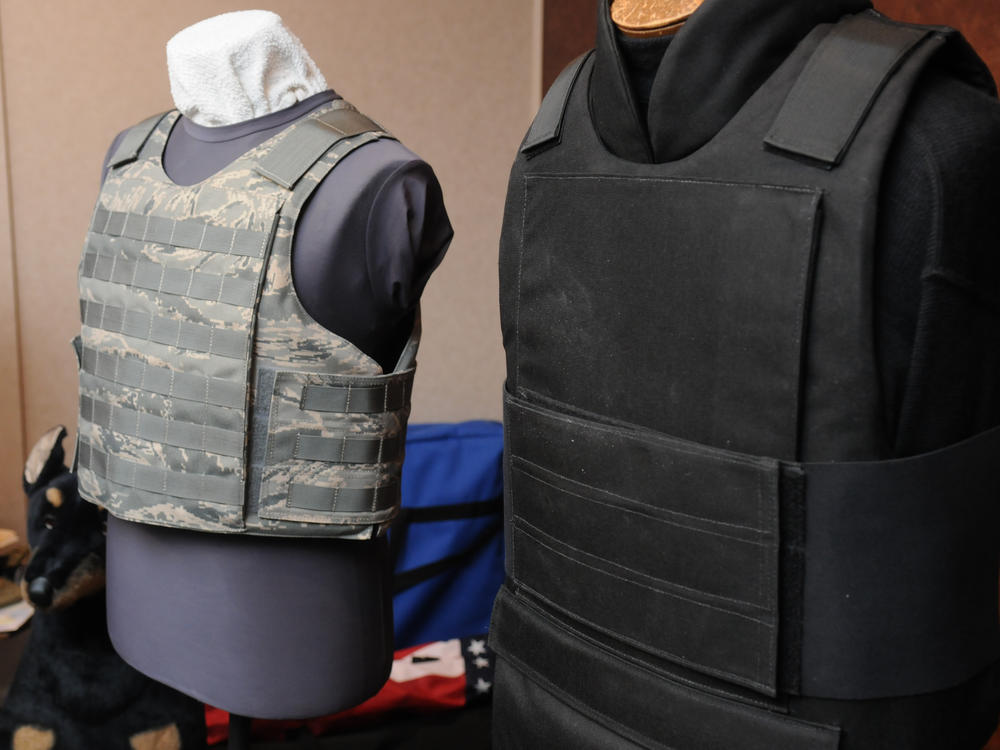Section Branding
Header Content
Body armor, worn by the Buffalo shooter, faces far fewer regulations than guns
Primary Content
When an 18-year-old man stepped into a Buffalo grocery store last Saturday with an AR-15-style rifle, the store's security guard tried to stop the shooting by firing his own weapon back at the shooter.
But the security guard's fire was stopped by the shooter's body armor, authorities say. Then, the shooter shot and killed the guard, Aaron Salter.
"The security guard that was killed was a retired Buffalo police lieutenant. [He] engaged the shooter, who was wearing tactical gear and body armor. [He] did shoot and hit the suspect, but it did not penetrate the body armor," said Buffalo Mayor Byron Brown in an interview with NPR.
The Buffalo shooter's decision to wear body armor makes him the latest mass shooter in recent years to do so, following high-profile cases in Colorado, Texas and California.
In the U.S., body armor is subject to far fewer restrictions nationwide than guns. Its use in mass shootings has ticked up in recent years, experts say, raising questions about the equipment's accessibility and fears about the deadliness of such shootings, if police are unable to use deadly force to stop them.
Who can buy body armor?
The only purchase limitation in most of the U.S. is a federal ban on possession of body armor by people convicted of violent felonies. Connecticut restricts body armor sales further by requiring sales to be face-to-face transactions.
In a sharp contrast with firearms, no states require background checks, permits or registration.
Some retailers decline to sell to civilians. But others sell products to anyone who will purchase it.
Cheap vests run from about $200 to $300. At the highest end, body armor and ceramic plates can be very expensive, as much as thousands of dollars for a complete set.
How is body armor used?
Body armor is designed to protect the wearer from injury. Although it is generally accessible to the civilian public, the vast majority of body armor is purchased for use by military, law enforcement and security organizations.
Body armor varies widely. Vests are generally made of a flexible ballistic fabric, and plates can be inserted to increase protection.
At the low end, soft body armor can protect the wearer from knives and handgun bullets. Someone wearing the highest-level armor with ceramic plates can survive a direct hit by rifle ammunition.
Depending on the type of armor and the intensity of the situation, the wearer may not even notice being hit by a bullet, says Aaron Westrick, a body armor expert and criminal justice professor at Lake Superior State University.
"The adrenaline is running high, and the immediate effect of getting struck on body armor most of the time is pretty much nothing," he said. "Later on, you're going to have a bruise and you might be sore."
How often has body armor been used by mass shooters?
Body armor is expensive, and it's rarely used by typical criminals, Westrick says.
But he says he sees body armor used more often by ideologically inspired shooters and shooters that meticulously plan their attacks, as the Buffalo suspect allegedly did.
The number of mass shooters who wore body armor has trended upwards in recent years, according to data collected by The Violence Project, a nonpartisan group that researches gun violence.
That group found that at least 21 mass shooters over the last 40 years have worn body armor – the majority in the last decade.
Some of the most high-profile shootings in recent memory were carried out by shooters who wore body armor. That includes the 2012 movie theater shooting in Aurora, Colo., the 2015 San Bernardino attack and last year's shooting at a King Soopers grocery store in Boulder, Colo.
In 2017, the shooter at the First Baptist Church in Sutherland Springs, Texas was confronted by Stephen Willeford, a former NRA firearms instructor, who fired back with an AR-15 of his own. Willeford's first two shots apparently struck the shooter in his body armor, he said he learned later. Only when Willeford was able to aim at the side of the shooter's torso did his fire land.
Police training has changed to reflect the reality of body armor, Westrick says. "Training has been modified to circumvent armor if it's present," he said.
Have there been any efforts to regulate body armor in the U.S.?
There have been unsuccessful attempts to ban civilians from possessing the types of higher-rated body armor designed to protect the wearer from bullets fired by rifles.
Legislators have introduced bills in Congress, typically after a high-profile shooting in which the shooter was wearing body armor. None have passed.
In 2014, a shooting in southern California in which a man wearing body armor and armed with an AR-15 rifle killed two people and injured a Riverside County sheriff's deputy. After the attack, Rep. Michael Honda of California, a Democrat, introduced what the Responsible Body Armor Possession Act.
"This bill will keep military body armor out of the wrong hands," Honda said at a press conference announcing the bill. "It would ensure that only law enforcement, firefighters and other first responders would be able to access enhanced body armor."
In 2019, Sen. Chuck Schumer of New York, a Democrat, proposed another body armor bill. Schumer's bill would have required civilians to acquire FBI permission to buy armor.
"Shockingly, with the click of a mouse, the scroll of a thumb or the dialing of a phone, just about anyone can order-up the kind of advanced armor or tactical law enforcement gear we see used in wars or all-out law enforcement raids, and that is unacceptable and needs to change," he said then.
Those proposals, and others like them, haven't gone far.
In New York, where Saturday's shooting took place, legislation was introduced last year that would ban most New Yorkers from owning body armor. That bill was stricken.
Copyright 2022 NPR. To see more, visit https://www.npr.org.

